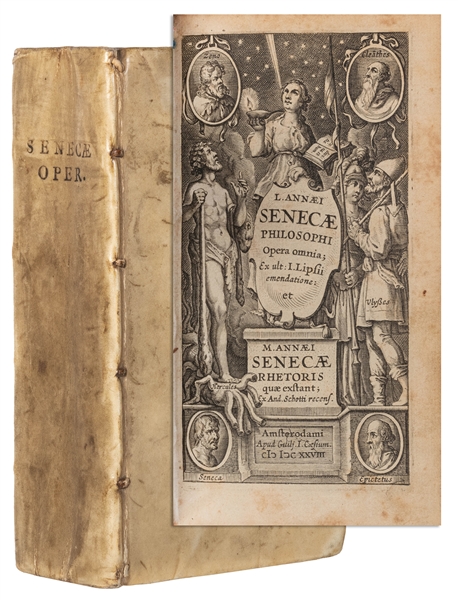SENECA, Lucius Annaeus (ca. 4 B.C.-65 A.D.). Tragoediae . With the commentaries of Gellius Bernardinus Marmita and Daniel Caietanus. Venice: Matteo Capcasa (di Codeca), 18 July 1493. Super-chancery 2 o (320 x 213 mm). Collation: A 4; a-b 8 c-z 6 & 4 (A1 blank, A2r Apologia from Caietano to Leonardo Mocenigo, A3r poem by Polydorus Cabaliatus defending his teacher Caietano, A3v letter from Marmita to Guillaume de Rochefort, A4r prefatory remarks by Marmita addressed to Rochefort, A4v blank; a1r text with commentary, &4r colophon and register, &4v blank). 150 leaves, 5-150 foliated. 60 lines of commentary surrounding text. Types: 3:108R; 4:84R; 82Gk. Opening woodcut initials; elsewhere 2- to 4-line initial spaces with printed guide letters. Initials and a few paragraph marks supplied in red or blue. Evidence of pinholes in lower outer margin of last few leaves. (A few leaves slightly darkened, narrow marginal dampstain to a few leaves at front, marginal wormholes in first and last few leaves.) A FINE PILLONE BINDING WITH FORE-EDGE PAINTING BY CESARE VECELLIO Binding : contemporary blind-tooled brown goatskin over thin wooden boards, bound for Antonio Pillone by Hobson's Belluno Bindery A, sides panelled with triple fillets, outer and central compartments adorned with widely spaced small 4- and 5-petalled rosette tools, two inner borders composed respectively of a repeated blossom and leaf tool and leafy tool, 4 (of 10) brass bosses, nails subsisting from 2 of the missing bosses, one (of two) fore-edge clasps, spine with two double raised bands tooled with intersecting triple fillets, vellum free endleaves (lacking some bosses and half of one clasp as above, a few small scrapes and wormholes, endleaves stained by offsetting from leather turn-ins), preserving many deckle edges; folding cloth case. Fore-edge painting : full-length portrait of the author lecturing, in a red toga and white turban, holding a book open toward his audience and pointing to a passage, author's name and title lettered vertically, abbreviated author's name and title initial lettered horizontally at bottom, upper and lower edges stained gray-blue and marbled in red. Provenance : Antonio Pillone (1464-1533): binding -- his son Odorico Pillone (1503-1593): fore-edge painting -- Sir Thomas Brooke (1830-1908): bookplate; sold by his heirs in 1957 as part of the Pillone collection to Pierre Berès (catalogue Bibliothèque Pillone , 1957, no. 57; catalogue 67, Un groupe de livres Pillone , no. 38) -- [Quaritch 1988] Second Venetian edition of Seneca's Tragedies, third edition with the commentary of Marmita, the first with Caietano's additional commentary. Seneca's nine tragedies, full of violence and horror, exerted a profound influence on poets and playwrights of the Italian Renaissance as well as on their successors in Tudor England. The printer Matteo Capcasa, a native of Parma, worked at Venice for a decade from 1485, printing mostly vernacular works, including a number of finely illustrated editions. This copy is one of 172 books from the celebrated Pillone library with fore-edge or binding decoration by Titian's cousin Cesare Vecellio (1530-1600). Vecellio's enhancements were commissioned in the 1580s by Odorico Pillone or possibly by his son Giorgio, friends of Vecellio, whose family stemmed from the same valley in the foothills of the Alps, and who mentions the Pillones' collections in his famous costume-book, De gli habiti antichi et moderni (Venice 1590). Vecellio painted the fore-edges of the majority of the books, which are bound in boards, while 21 books are in simple vellum bindings whose covers he and other artists filled with pen-and-ink drawings. Thanks to their unusual decoration and to the fact that the library remained intact until the 1950s, all of the Pillone books have been preserved in their original bindings. This is a particularly fine example of the group of bindings commissioned by Antonio Pillone ca. 1507-1510 from one of two Bellu
SENECA, Lucius Annaeus (ca. 4 B.C.-65 A.D.). Tragoediae . With the commentaries of Gellius Bernardinus Marmita and Daniel Caietanus. Venice: Matteo Capcasa (di Codeca), 18 July 1493. Super-chancery 2 o (320 x 213 mm). Collation: A 4; a-b 8 c-z 6 & 4 (A1 blank, A2r Apologia from Caietano to Leonardo Mocenigo, A3r poem by Polydorus Cabaliatus defending his teacher Caietano, A3v letter from Marmita to Guillaume de Rochefort, A4r prefatory remarks by Marmita addressed to Rochefort, A4v blank; a1r text with commentary, &4r colophon and register, &4v blank). 150 leaves, 5-150 foliated. 60 lines of commentary surrounding text. Types: 3:108R; 4:84R; 82Gk. Opening woodcut initials; elsewhere 2- to 4-line initial spaces with printed guide letters. Initials and a few paragraph marks supplied in red or blue. Evidence of pinholes in lower outer margin of last few leaves. (A few leaves slightly darkened, narrow marginal dampstain to a few leaves at front, marginal wormholes in first and last few leaves.) A FINE PILLONE BINDING WITH FORE-EDGE PAINTING BY CESARE VECELLIO Binding : contemporary blind-tooled brown goatskin over thin wooden boards, bound for Antonio Pillone by Hobson's Belluno Bindery A, sides panelled with triple fillets, outer and central compartments adorned with widely spaced small 4- and 5-petalled rosette tools, two inner borders composed respectively of a repeated blossom and leaf tool and leafy tool, 4 (of 10) brass bosses, nails subsisting from 2 of the missing bosses, one (of two) fore-edge clasps, spine with two double raised bands tooled with intersecting triple fillets, vellum free endleaves (lacking some bosses and half of one clasp as above, a few small scrapes and wormholes, endleaves stained by offsetting from leather turn-ins), preserving many deckle edges; folding cloth case. Fore-edge painting : full-length portrait of the author lecturing, in a red toga and white turban, holding a book open toward his audience and pointing to a passage, author's name and title lettered vertically, abbreviated author's name and title initial lettered horizontally at bottom, upper and lower edges stained gray-blue and marbled in red. Provenance : Antonio Pillone (1464-1533): binding -- his son Odorico Pillone (1503-1593): fore-edge painting -- Sir Thomas Brooke (1830-1908): bookplate; sold by his heirs in 1957 as part of the Pillone collection to Pierre Berès (catalogue Bibliothèque Pillone , 1957, no. 57; catalogue 67, Un groupe de livres Pillone , no. 38) -- [Quaritch 1988] Second Venetian edition of Seneca's Tragedies, third edition with the commentary of Marmita, the first with Caietano's additional commentary. Seneca's nine tragedies, full of violence and horror, exerted a profound influence on poets and playwrights of the Italian Renaissance as well as on their successors in Tudor England. The printer Matteo Capcasa, a native of Parma, worked at Venice for a decade from 1485, printing mostly vernacular works, including a number of finely illustrated editions. This copy is one of 172 books from the celebrated Pillone library with fore-edge or binding decoration by Titian's cousin Cesare Vecellio (1530-1600). Vecellio's enhancements were commissioned in the 1580s by Odorico Pillone or possibly by his son Giorgio, friends of Vecellio, whose family stemmed from the same valley in the foothills of the Alps, and who mentions the Pillones' collections in his famous costume-book, De gli habiti antichi et moderni (Venice 1590). Vecellio painted the fore-edges of the majority of the books, which are bound in boards, while 21 books are in simple vellum bindings whose covers he and other artists filled with pen-and-ink drawings. Thanks to their unusual decoration and to the fact that the library remained intact until the 1950s, all of the Pillone books have been preserved in their original bindings. This is a particularly fine example of the group of bindings commissioned by Antonio Pillone ca. 1507-1510 from one of two Bellu















Testen Sie LotSearch und seine Premium-Features 7 Tage - ohne Kosten!
Lassen Sie sich automatisch über neue Objekte in kommenden Auktionen benachrichtigen.
Suchauftrag anlegen